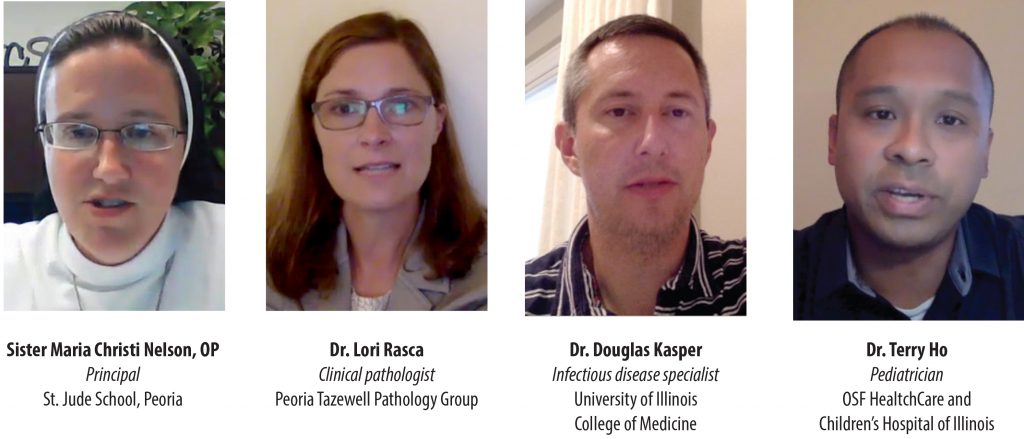Three area physicians share perspective on reopening of schools in new video

As the debate continues about the safety of in-person instruction during a pandemic, St. Jude School in Peoria has made available to families diocese-wide a video with the “clear, simple voices” of three physicians who provide details about the coronavirus, what it looks like in children, and why this is the time for them to go back to class.
Moderated by Sister Maria Christi Nelson, OP, principal, the video runs just under 21 minutes and was recorded during a Zoom session with the doctors, all of whom are the parents of St. Jude students. It is available for viewing at cdop.org under the tab for “Catholic Education.”
Dr. Lori Racsa, a clinical pathologist with a subspecialty in medical microbiology who works with the Peoria Tazewell Pathology Group at UnityPoint Methodist, gave an overview of the coronavirus from a scientific standpoint.
Dr. Douglas Kasper, an infectious disease physician who teaches at the University of Illinois College of Medicine in Peoria, talked about how to gauge the risk of exposure in school, out of school, and within the home.
“I know there’s a lot of anxiety and stress and fear about sending your kids to school for a long day in a mask. Know that they can do this and they can do this with our help.” — Dr. Terry Ho, Pediatrician, OSF HealthCare and Children’s Hospital of Illinois
Dr. Terry Ho, a pediatrician at OSF HealthCare and Children’s Hospital of Illinois, offered his insights on how the virus affects children.
In addition to working with St. Jude, the doctors have also been part of the team consulted by Dr. Sharon Weiss, superintendent of Catholic schools for the Diocese of Peoria, in developing the Diocesan Plan for Reopening Schools. This can also be found at cdop.org, along with a PowerPoint presentation.
MINIMIZING RISK
“There’s so much information out there to read that videos are clearer in terms of communications and shorter is better at this time for parents to understand in succinct, simple ways,” Sister Maria Christi told The Catholic Post. “If you can’t be there in person, video is the next best bet.”
That direct communication is also important at a time when there’s so much that can be misinterpreted, she said.
“In this whole time of COVID and going through a pandemic, none of us are used to this. None of us are comfortable with this. But this is what they live their whole life for — not just pandemics but guiding people through health crises,” Sister Maria Christi said of Drs. Racsa, Kasper and Ho. “Having them and their reassurance and their confidence, it’s miraculous how they convey that to anyone who’s listening to them.”
Each of the doctors emphasized the need to follow safety protocols like wearing masks, washing hands often, and distancing from others to make it harder for droplets to be transmitted from one person to another.
“If local rates for disease remain low and these restrictions with distancing and masking remain in place, then we believe we can avoid high-risk exposures within the school settings to both the students and the faculty.” — Dr. Douglas Kasper, infectious disease specialist, University of Illinois College of Medicine in Peoria
“Masking has become a norm for all of us,” Dr. Ho said. “I know there’s a lot of anxiety and stress and fear about sending your kids to school for a long day in a mask. Know that they can do this and they can do this with our help.”
Dr. Kasper said the policies for diocesan schools were written to help people avoid high-risk behavior. According to the Centers for Disease Control and Prevention, the highest risk comes from being exposed to someone who is confirmed to have COVID-19 by standing within six feet of them for up to 15 minutes while not wearing a mask or other protective gear.
“If local rates for disease remain low and these restrictions with distancing and masking remain in place, then we believe we can avoid high-risk exposures within the school settings to both the students and the faculty,” he said.
AN ADDED SAFEGUARD
Dr. Ho said studies have shown that COVID-19 doesn’t affect children like it does adults. If they do get it, they are more likely to have a milder case.
“There’s a lot of talk about what’s essential. What we do know is education is essential,” he said. “There’s a lot of benefits for kids being in school in addition to the education they receive.”
“You really have that reassurance of faith and trust at the end of the day when you know that God’s always taken care of us before and he’ll take care of us even in a pandemic returning to school. We have our rock. We’ve always had our rock. That’s what our schools are built on.” — Sister Maria Christi Nelson, OP, Principal, St. Jude School, Peoria
Dr. Ho has been telling the families who come to see him that he’s “100 percent ready” for his kids to be back in school and trusts that it’s a safe environment.
“Once we’re back in school for a week or two I think a lot of anxiety will melt away from teachers and parents and kids,” said Sister Maria Christi, who welcomed students at St. Jude on Aug. 12. “We just have to live in it and then everybody will see, ‘We can do this.’”
Catholic schools have an extra safeguard, she said.
“You really have that reassurance of faith and trust at the end of the day when you know that God’s always taken care of us before and he’ll take care of us even in a pandemic returning to school,” she said. “We have our rock. We’ve always had our rock. That’s what our schools are built on.”





